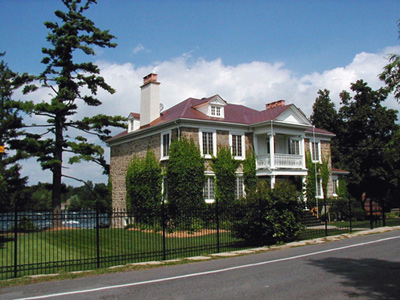de Salaberry House National Historic Site of Canada
Chambly, Quebec

General view
© Agence Parcs Canada / Parks Canada Agency, 2002.
Address :
18 De Richelieu Street, Chambly, Quebec
Recognition Statute:
Historic Sites and Monuments Act (R.S.C., 1985, c. H-4)
Designation Date:
1968-11-28
Dates:
-
1814 to 1815
(Construction)
-
1814 to 1829
(Significant)
Event, Person, Organization:
-
Lieutenant-Colonel Charles-Michel d’Irumberry de Salaberry
(Person)
-
Pierre Papineau
(Builder)
Other Name(s):
-
de Salaberry House
(Designation Name)
Research Report Number:
1966-063, 1968-050, 1968-070, 2009-CED-SDC-030
Plaque(s)
Existing plaque: 18 de Richelieu Street, Chambly, Quebec
This residence was built in 1815 for Lieutenant-Colonel Charles-Michel d’Irumberry de Salaberry. This hero of the War of 1812 repulsed an American force far larger than his own at the Battle of the Châteauguay in 1813. He lived in this house until his death in 1829. This imposing mansion is typical of villas constructed in the Montréal region in the early 19th century. The house was originally inspired by the Picturesque movement and was modified over time. Its harmonious proportions, symmetrical five-bay facade, and two-storey columned portico with pediment, now create an overall impression of British Classicism.
Description of Historic Place
The de Salaberry House National Historic Site of Canada is located in front of the Chambly Rapids in Chambly, Québec. The site consists of a large, three-storey stone house representative of vernacular Montréal villas built in the early 19th century. The house includes a low hipped-roof featuring two gable dormers, two side chimneys and an imposing columned portico. It was constructed under the orders of Lieutenant-Colonel Charles-Michel d’Irumberry de Salaberry from 1814 to 1815. De Salaberry lived in the house until his death in 1829. Official recognition refers to the limits of the property at the time of designation.
Heritage Value
The de Salaberry House was designated a national historic site of Canada in 1968 because: it’s masonry construction and general form is representative of the style of villas common in the Montreal region in the first quarter of the 19th century; Lieutenant-Colonel Charles Michel d’Irumberry de Salaberry built the house in 1815 and lived there until his death in 1829.
The de Salaberry House was constructed under the orders of Lieutenant-Colonel Charles-Michel d’Irumberry de Salaberry between 1814 and 1815. De Salaberry was known as “the hero of Châteauguay” for his role in rebuffing American troops under Major-General Wade Hampton’s command at the Battle of Châteauguay on the 26th October, 1813. He lived in this house with his wife until his death in 1829.
The de Salaberry house is representative of vernacular Montréal villas built in the early 19th century. It is a large, three-storey stone house, which features two large parapeted chimneys and numerous casement windows. It is a rectangular, harmoniously proportioned building that makes use of cut stone building materials and exhibits common features of houses from the early 19th century, including the casement windows with plain trim and dormer window surrounds. It also features a classically detailed pediment and columns.
Sources: Historic Sites and Monuments Board of Canada, Minutes, 1968, 2009.
Character-Defining Elements
Key elements that contribute to the heritage character of the site include: its location on Richelieu Road, in Chambly, Quebec; its setting facing the Chambly Rapids, along the route which continues on to Fort Chambly National Historic Site of Canada; its large three-storey massing, including a cellar and a kitchen, with a three-storey semi-hexagonal projecting bay set in the centre of the rear elevation; its cut stone rectangular form and construction; its low hipped roof, featuring two gable dormers; its large, symmetrically-placed multi-paned casement windows, including one on each façade of the semi-hexagonal bay projection; the double staircase at the rear of the house leading to the second storey; the main entrance, bordered by lateral paned windows and pilasters, set on an imposing columned portico with a gabled upper-storey balcony; the French door on the rear elevation and the wide stone terrace overlooking the Richelieu River; any interior features and details associated with the residency of de Salaberry from 1814 to 1829, including fireplaces, and pine floors, shutters and ceilings; viewscapes from the site across the Chambly Rapids.